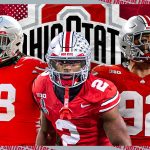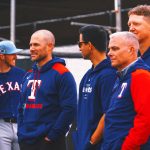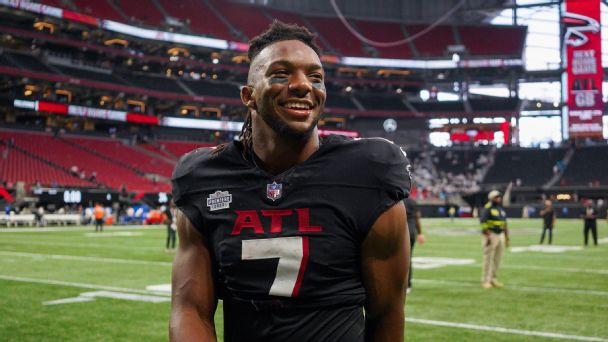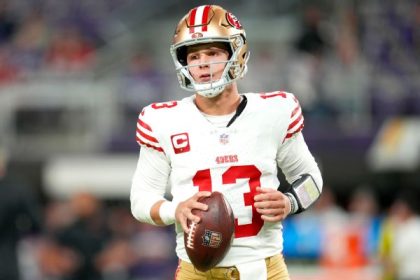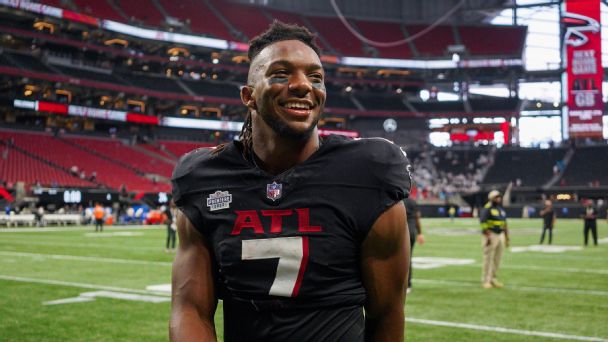
BIJAN ROBINSON STARTED in the slot, motioned inside and stopped just past his center. What happened next led to the Atlanta Falcons‘ first touchdown of the season.
Robinson turned back the way he came and was lined up where an offset tight end might be when the ball was snapped. He caught a swing pass behind the line of scrimmage, back-juked one defender, broke an attempted tackle by two others and took it 11 yards to the end zone.
The play was an accentuation of what the Falcons have been building over the last three years.
What began in Atlanta with Cordarrelle Patterson eventually grew to a set of diverse pass-catchers.
Robinson, the team’s No. 8 pick this year, is the latest addition to a group the Falcons have collected since hiring head coach Arthur Smith and offensive coordinator Dave Ragone in 2021. From Patterson to first-round picks Kyle Pitts, Drake London and Robinson, each share one obvious quality: Versatility.
Sunday showed a glimpse of what could come in Atlanta. Robinson, listed as a running back, lined up everywhere.
“You guys kind of looked at me — ‘running back,'” Smith said. “But he’s a football player. He’ll line up all over the place, and there’s still more he can do.”
What started as philosophies when Smith and Ragone were young Tennessee Titans coaches in 2011 blossomed into the potential for a position agnostic offense.
Ragone had come from a career as an NFL quarterback, a radio host in Louisville, Kentucky and a season as a quarterbacks coach in the United Football League. Smith bounced around the NFL and college football as a graduate assistant, intern and defensive quality control coach.
Over three seasons, Smith and Ragone became close, moving up the coaching roster: Smith from defensive to offensive quality control coach and then a tight ends/offensive line assistant; Ragone from receivers coach to quarterbacks coach.
They talked about their lives, but many conversations centered around what brought them to Nashville.
“Obviously it goes beyond the field with he and I, but ultimately, football through the same lens with he and I,” Ragone said. “That’s probably, if you’re a head coach with a coordinator, it’s probably what you want, right?
“You want to be able to see it through the same [understanding], it doesn’t mean you can’t have an opinion differently but ultimately big picture-wise, you want to have the same conversation.”
Those conversations through hours of watching film created ideas built on the concept of versatility.
“[Smith] nor myself are thinking, ‘OK, man, we’re going to be this revolutionary,'” Ragone said. “We’re just really just trying to help the players.”
SMITH AND RAGONE’S shared vision goes beyond football. They talk about other sports constantly, and there’s a shared love of another sport which has enhanced their thinking: Basketball.
Smith grew up in Memphis and went to North Carolina with a deep hoops appreciation. Ragone played football at Louisville, where basketball ruled. They shared an affinity for studying successful coaches and a theme came through: Find good players, accentuate their strengths and try to get the most out of them.
Ragone admired Gregg Popovich, Steve Kerr, Tom Izzo, Mike Krzyzewski and Louisville under Denny Crum and Rick Pitino, and how they pushed players and evolved.
“Think about it, though, you can’t find a center with his back to the basket in the NBA really, right? That’s gone,” Ragone said. “Now, the question becomes, right, cause you’re always trying to at least anticipate the next pitch.
“You’re wondering at what point does the NBA start going back to the 80s NBA where somebody’s back to the basket, you’ve got a great post like [Hakeem] Olajuwon or [Patrick] Ewing and the defense doesn’t know how to guard it anymore because they’re so used to guarding on the perimeter, right?”
Smith believes some coaching philosophies can translate no matter the sport. A Tar Heel, Smith never met Dean Smith but read often about him and studied what he did. He also saw how Roy Williams handled pace of play and transition.
The toughness of the Memphis Grizzlies under Lionel Hollins and Dave Joerger in the 2010s, when the club made seven straight playoff appearances, stuck out as well. They did something different — “make it physical in a pace-and-space game.”
Smith said he’s also talked with University of Houston basketball coach Kelvin Sampson as a way to learn because he’ll “take ideas from anybody, in any industry.”
“You study it,” Smith said. “And see what translates and what doesn’t.”
The NFL is a “copycat” league. What might develop in Atlanta could look more like the NBA, which runs offenses where players aren’t tied into strict roles.
“We got a lot of guys that can make plays and how we want to operate and what we think the best game plan is to deploy those guys and different packages,” Smith said. “And they can line up all over the place.
“I think that’s what makes us unique.”
ON MONDAY NIGHT, Smith and Ragone sat over an Italian takeout dinner from Napoli’s inside the Falcons’ facility and threw ideas up on the grease board.
Do they want to motion a player here, try a different personnel there? If they find something they like, they bring it to practice. If the players grasp the concept there and it looks smooth, it enters the game plan that week — or a future one depending on the opponent.
“When you have a strong relationship, like that’s what I felt I had with Mike Vrabel, where you trust and you’re trying to do what’s best for the team,” Smith said. “Sometimes that’s hard to build. You talk about chemistry on a team, it’s hard to build on a staff.
“That certainly helps and that’s what makes my job a lot easier, having someone like Dave.”
That trust has allowed creativity. Smith describes this approach as “healthy” and, combined with their thought processes, has created a good working environment.
Philosophies aside, the only way coaches can get creative is if they have the players to make it happen. For instance, Smith said the Warriors couldn’t have evolved if Steph Curry’s skillset didn’t encourage it.
The potential for positionless football players on offense starts not with NFL minds, but Pee Wee football precedent. Smith believes the explosion of 7-on-7 football, players playing more positions and learning skills earlier, altered the modern player. Rare is the player who has been strictly a running back, receiver or tight end their whole lives.
“A lot of these high school and college offenses are wide open and spread out, so guys that may play wide receiver in college, they may turn into tight ends,” Smith said. “Guys who are running backs may have skill sets, probably I imagine 30 years ago coming out you were in the I and heavy personnel and that’s what they did.
“Then you moved on and you had your Marshall Faulks, Kevin Faulks that were options out of the backfield.”
It’s in the same thought process where Atlanta’s positionless consideration started with the signing of Patterson in 2021. The idea to move him from receiver to running back started before Atlanta. Other coaches considered it and there had been some success in Chicago under Ragone, then the Bears’ quarterbacks coach, and former Falcons quarterbacks coach Charles London, then Chicago’s running backs coach. When the duo arrived in Atlanta, they wanted to bring Patterson, too.
Patterson had a career year lining up all over Atlanta’s offensive formations. Position switching in 2021 and 2022 happened often with varying levels of success. Feleipe Franks transitioned from a quarterback to a tight end. Parker Hesse continued his move from defensive lineman to tight end. Avery Williams, the team’s punt returner, switched from cornerback to running back.
Atlanta gathered versatile players with their first-round picks: Pitts in 2021, London in 2022 and Robinson with the No. 8 pick this year. Veteran moves saw similar impacts. Atlanta traded for tight end Jonnu Smith, who could play slot, outside or as a fullback, and signed receiver Mack Hollins, who once considered moving to tight end.
“We got a lot of guys that can play a lot of positions, man,” Smith said. “And you give yourself a lot of variety to give yourself a lot of leeway with having that particular aspect right there.”
The Falcons created an offense where their personnel could line up in anything from a jumbo set to five wide using the same set of players. On Sunday it was commonplace, according to ESPN Stats & Information.
Of Robinson’s 31 snaps, 20 came in the backfield, four in what is considered the slot, four in a spot typically used by a tight end and three as a receiver. And nine of those 20 backfield snaps were routes run. When the Falcons drafted Robinson, they made it clear they valued him as more than a running back — and Robinson said this week he’s comfortable with their plan.
Pitts’ 29 snaps had him in the slot 11 snaps, wide right 10 times and in a tight end spot on eight plays.
London’s 43 snaps had him 32 times wide left, seven wide right and four times in the slot. Hollins played 23 snaps out wide, two in a tight end spot and six in the slot.
Smith lined up in the backfield three times, in the slot five times, out wide twice and as a tight end 15 times. MyCole Pruitt lined up at tight end 20 times, in the slot once and the backfield twice.
Of the Falcons skill players who had at least 50% of snaps, only Tyler Allgeier lined up in just one spot, with all 26 snaps in the backfield.
“We do a lot of different things, not just me but everybody in this offense,” Robinson said. “How they want to use us skill players, they use us to create mismatches and create matchups in space.
“They want to do everything, as much as possible, to get us in space.”
Robinson said they do this to “confuse the defense” in an effort to have more effective drives. On Sunday, this all happened without Patterson, who missed the opener with a thigh injury. But the Falcons added a new position for their original positionless player: “Joker.” The what-can-he-do of the Joker depends on the player, but the role of it will remain the same.
“Well, he can play a lot of different spots,” Smith said. “From quarterback to wideout to running back to tight end.”
When considering using a player in a multitude of ways, Ragone said the first thing Atlanta looks for is “football intelligence.”
Ragone said those can be “sometimes hard to identify,” but they see it when they watch plays and a player does something different than the expected play, but made it work anyway.
“You want to surround yourself, coach or player,” Ragone said. “With as many of those guys as possible.”
This can create offensive leverage because defenses don’t know what personnel to play. It’s the ultimate way Smith can use deception — something he learned from his former boss in Tennessee, Mike Mularkey — to gain an advantage.
To Atlanta’s starting quarterback, Desmond Ridder, it could lead the offense to have “explosivity.” Conceptually, he said, it’s all similar. Who plays where is the differentiator.
“Everything in the league is about one-on-one matchups, so we try to get the best matchups as possible, especially when they go man coverage,” Ridder said. “To make just mismatches all around the field.”
WHILE MOST POSITIONLESS focus is on offense, it has spread to defense. The Falcons cross-train defensively — they have worked players at corner and safety in the past, and inside as a slot corner as well as either safety and nickel corner.
This camp, Bud Dupree and Lorenzo Carter have played defensive end and outside linebacker. When the Falcons signed Kaden Elliss, it wasn’t clear whether he’d be an inside, outside or middle linebacker.
Smith said when he was looking for a new defensive coordinator he’d want to find a coach who could work with hybrid players, saying “structurally, it’s really about being flexible.” Defensive coordinator Ryan Nielsen, in his interview process, agreed.
“It’s a combination because you don’t want to be so rigid, ‘you got to be like this,’ then we wouldn’t be putting guys in the right positions,” Nielsen said. “So there’s a combination of that, but we do want more players to be able to play more positions.
“It’s a long season. We’re going to have injuries. The more you can do, if a safety can play nickel or a D-end can play D-tackle, it helps us out.”
Atlanta isn’t the only team looking at players like this. Washington coach Ron Rivera viewed Shaq Thompson similarly in Carolina, knowing he’d played running back before, had a college career as a safety and wanted to grow him into a linebacker. The Panthers knew they could play him at linebacker, safety or nickel.
“For us, we didn’t have to go to our sub package right away,” Rivera said. “We could go to what we called Buffalo, and that was basically a big nickel, which was Shaq.”
Dallas’ Micah Parsons can play all over a front seven. In Los Angeles, Rams coach Sean McVay called Aaron Donald “a unique deal” because of his skill set. When Jalen Ramsey was with the Rams, they used him in a multitude of ways.
“Those guys that are legitimate weapons in a lot of phases,” McVay said. “That can give you the opportunity to put some pressure on the opposing defense or offense.”
It’s part of a growing NFL trend on both sides of the ball. On offense, Kyle Shanahan has used Christian McCaffrey and Deebo Samuel in multiple ways. Rivera had McCaffrey in Carolina — and has had Curtis Samuel both with the Panthers and Washington.
It’s about finding ways to be different and creating defensive chaos, or what McVay called “a guessing game.”
“In a lot of instances it starts with the players in those matchups and then it’s the scheme and things like that, so that’s where it definitely does,” McVay said. “You might say we’re trying to attack this person, putting on this coverage structure, and now that guy is at the point of attack and now you’re like, ‘I don’t like this play as much.’
“It puts second-guessing in your mind and creates that extra consternation and it’s a good thing.”
Finding these players starts with scouting. On offense, Pittsburgh coach Mike Tomlin said if players can win one-on-one matchups when they have the ball — and have “contact balance” — it sparks the potential idea to use the guy in more places. On defense, Tomlin looks at tackling skills and a player’s movement.
This — along with the continued growth of 7-on-7 — could lead to more hybrid defensive looks as a way to counter a potential offensive trend and eliminate the strain it could put on defenders.
Falcons linebacker Troy Andersen in Atlanta played multiple positions in college. The Falcons saw his speed and instincts, so they knew he could potentially line up multiple spots. Elliss played all three linebacker spots in his career. Safety Jessie Bates III can play from down in the box to deep safety — all part of Atlanta’s larger plan.
“We want versatile players at every position,” general manager Terry Fontenot said. “Because that’s the type of football team we have.”

